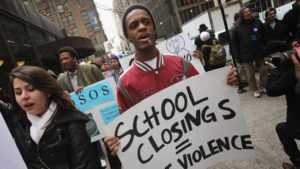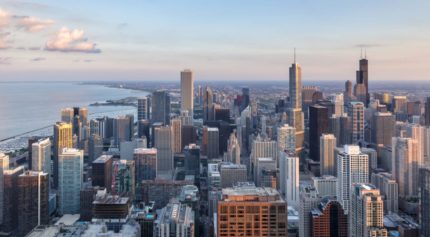
At least that’s the claim made by local community leaders like Rev. Dr. Otis Moss III, the Senior Pastor of Trinity United Church of Christ on Chicago’s South Side, the former church home of President Obama.
There were serious concerns in the Black community as some victims and shooters turned out to be as young as 12 years old. While there was widespread handwringing about the violence, there was a lack of concomitant government intervention focusing on the deteriorating educational systems, high poverty rates, unstable economy and other systemic issues that have allowed crime to grow in the city.
Earlier this year, Chicago Mayor Rahm Emanuel announced his budget plan for next year and revealed that a substantial part of the budget would be focused on investing in police officers.
“The efforts coming from the political side are primarily focused on policing and policing is a small part of changing what happens in the city of Chicago,” Rev. Moss said in an exclusive interview with AtlantaBlackStar. “The real issue is, we have to do economic development, make sure there are jobs in our community, home ownership in the community—wherever there is home ownership there is lower crime and violence rates, a substantial amount of investment in the educational system and focus on returning citizens.”
Without the proper financial support from the government it could be incredibly difficult to address these problems efficiently.
Most of the programs that would have helped returning citizens have already been cut on a local and national level despite the fact that they managed to reduce Chicago’s recidivism rate by roughly 60 percent.
Rev. Moss said it is key to make sure that people who are returning to society from incarceration are “well-trained, educated and prepared to become productive.”
“Every program that we have seen instituted in Chicago around returning citizens that focuses on mentoring, job framing and preparing them for transition lowers the recidivism rate substantially,” he said.
Unfortunately, by Moss’s estimates, more than 50 percent of such programs have been cut by the federal and local government.
Over the past few years, constant budget cuts have caused the amount of mental health facilities in the community to dwindle so far that now Chicago’s jail is the largest mental health facility in the city.

Now that the Republican Party has gained control of Congress, there are even greater concerns that the government won’t be stepping in any time soon.
“As far as the people in government who could make a difference, the silence has been deafening on this one….I run the largest mental health hospital in the state of Illinois and maybe in the country,” the sheriff added.
Either way, Rev. Moss is confident the efforts that the people of Chicago have made with their own private investments have the potential to create the “New Chicago” that the community so desperately needs.
Without the help of government funding, community leaders have managed to create tech and art incubators, open youth development centers, grow urban farms, and launch projects that have helped to create jobs and improve educational efforts in the community.
“All of these pieces—this is coming from the ground up,” Rev. Moss added. “This is not a project that has been started by the governor or some senator or city hall. These are projects from people who are recognizing needs.”
Another major obstacle for leaders who are trying to rebuild the community and reduce violence is the fact that potential investors are discouraged by the locations where they want to continue building.

Without community efforts, these low-income, high-crime neighborhoods would be forced to essentially fend for themselves, which is what led to the creation of microgangs all across the city to begin with.
Rather than two or three large gangs dominating the area, the type of gang violence that has taken the streets of Chicago have been smaller gangs that act more like “cliques” and resort to violence in hopes of protecting themselves.
The members of these neighborhoods, especially the younger residents, adopt a “by any means necessary” approach to survival throughout their daily lives and in turn contribute to the violent gang culture that has made Chicago into a national symbol of urban chaos.


